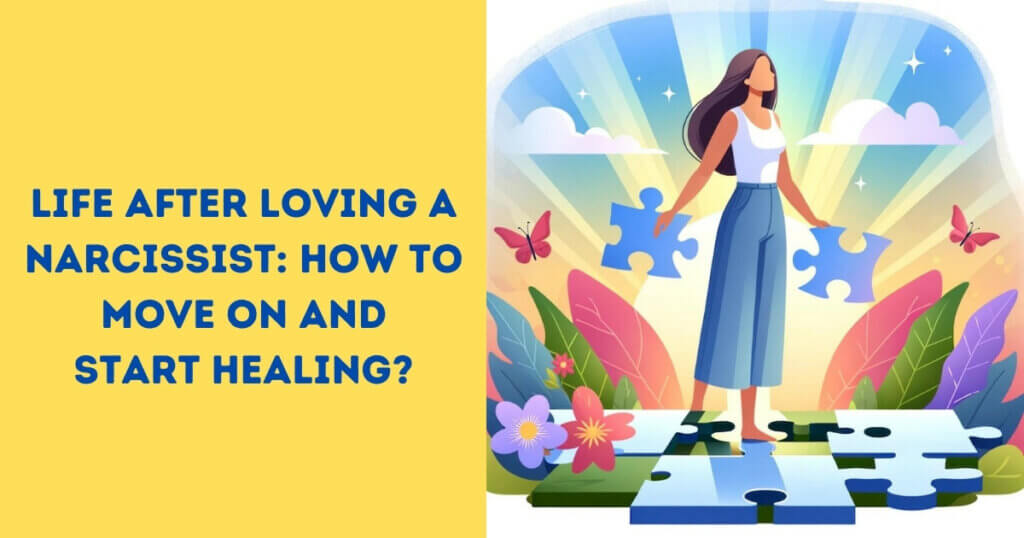Life after a relationship with a narcissist can feel like surviving a storm. The aftershocks may jolt you, leaving you wondering how to pick up the pieces and start anew. Moving on is a struggle, but healing, though challenging, is within your reach.
You’re left picking up the pieces, trying to make sense of the chaos. But how do you move on from such an experience, let alone start to heal? It’s not an easy journey but can lead to profound growth, self-discovery, and resilience.
Here are 14 important steps to take to start your healing.

#1 Acknowledge the Abuse:
The first step to begin recovery is to acknowledge that you have been in an abusive relationship. Denial will prevent any progress.
The healing journey begins when you face the hard truth: you’ve been in a relationship marked by narcissistic abuse. It’s a tough pill to swallow, but admitting it’s your first stride towards recovery.
You’ve likely spent a long time in denial, living in a distorted reality that the narcissist carefully crafted. Now, it’s time to shatter those illusions. You’ve been manipulated, controlled, and belittled. That’s not love, it’s abuse.
You mustn’t blame yourself. The fault lies with the abuser, not the victim. Acknowledging the abuse might be painful, but it’s a vital first step. It paves the way for healing, empowering you to reclaim control over your life and well-being.
#2 Learn About Narcissistic Abuse
Understanding the characteristics of narcissistic abuse helps validate your experiences and provides insight into what you experienced.
Diving into the dark world of narcissistic abuse, you’ll uncover a twisted web of manipulation, control, and deceit. This abuse takes on many forms, from emotional to physical, and is marked by a relentless assault on your self-esteem.
It’s a toxic cocktail that leaves you questioning your reality through gaslighting, a common tactic where the abuser denies or distorts your experiences. You may have endured love bombing, a phase where you’re showered with affection only to be met with cold indifference or hostility.
Recognizing these patterns can validate your experiences and confirm that it’s not you, it’s them. Understanding the insidious nature of narcissistic abuse is a crucial step in your healing journey. It’s the key to breaking free from self-doubt and reclaiming your worth.
#3 Self-Care and Self-Discovery
Taking care of your physical, emotional, and mental well-being is crucial. This is also a good time to discover and pursue your own interests and passions.
On your journey to healing from narcissistic abuse, prioritizing self-care and embarking on a path of self-discovery are pivotal steps.
Start by taking care of your body. Eat nutritious food, get enough sleep, and engage in regular exercise. Don’t neglect your emotional health, either. Allow yourself to feel, take time to grieve, and then let go. Reach out to loved ones or a professional counselor when emotions feel overwhelming.
For mental wellness, engage in activities that stimulate your mind and bring you joy. Read, write, solve puzzles, or learn a new skill.
This is also a perfect opportunity to rediscover yourself. Pursue hobbies, interests, and passions that you may have set aside. Make your well-being a priority, as this is key to your recovery.
#4 Establish Boundaries
Learning to set healthy boundaries is a major part of recovery as it helps you protect yourself from future abuse.
Learning to establish healthy boundaries is your shield against future abuse, playing a crucial role in your recovery journey. You’ve been through a lot, and it’s time to prioritize your needs and feelings.
It’s about saying ‘no’ when something doesn’t feel right and not feeling guilty about it. It’s about acknowledging your right to personal space and privacy. Create rules for yourself about what you’ll and won’t accept from others.
These boundaries aren’t just for others, they’re for you too. They’ll help you recognize your self-worth and avoid falling into the same patterns. It’s not easy and it takes practice, but setting boundaries is a powerful step towards healing and reclaiming your life after surviving a relationship with a narcissist.
#5 Limit Contact:
If possible, try to limit your contact with the narcissist. This can prevent further manipulation and harm.
While establishing boundaries helps protect your emotional health, severing or limiting ties with the narcissist is equally essential to prevent further manipulation and harm.
It’s crucial to remember that you’re not being rude or unkind by doing this; you’re simply protecting your well-being. If it’s impossible to cut off all contact, try to limit it as much as possible.
You might need to change your routines or avoid mutual friends for a while. This isn’t about running away, but rather about creating a safe space for yourself to heal.
#6 Grieve
Acknowledge and mourn your loss. This is a necessary part of the healing process, even if the relationship was unhealthy.
Despite the toxicity of the relationship, you must allow yourself to grieve and mourn the loss as part of your healing journey. This process isn’t about glorifying the unhealthy relationship you had but acknowledging the love you held and the pain of its loss.
It’s normal to feel a profound sense of grief, as you’re not only mourning the person but also the dreams, expectations, and future you envisioned with them.
Take your time with this process. It’s okay to feel the sadness and let it wash over you. It’s okay to miss them, even if they hurt you.
Remember, it’s not a sign of weakness but an indication of your humanity. Grieving is a testament to your capacity to love and a pivotal step in your journey towards healing.
#7 Journaling:
Writing about your feelings and experiences can provide a therapeutic outlet, helping you understand and process your emotions.
Putting your feelings and experiences down on paper can be a powerful way to gain clarity and process your emotions after surviving a narcissistic relationship.
Journaling allows you to express yourself freely, without judgment or interruption. It’s a safe space to vent, clarify your thoughts, and track your emotional progress.
As you write, you’ll likely notice patterns and triggers that you hadn’t before. You’ll see your growth and resilience clearly illustrated on the page. Pushing out your anger, fear, confusion, and sadness is okay. It’s equally okay to document your victories, no matter how small.
Don’t worry about perfect grammar or structure. This is your story. Embrace, learn from, and let it guide your healing journey.
#8 Mindfulness:
Mindfulness activities like meditation can help reduce stress and improve emotional health.
Practicing mindfulness, such as meditation, can be a powerful tool in your healing journey, helping to reduce stress and improve emotional health. By focusing on the present moment, you can tune out the noise and give yourself the necessary calmness.
This doesn’t mean ignoring your past experiences but acknowledging them without letting them dominate your thoughts. You can start by taking a few minutes daily to meditate, focusing on your breath or a simple mantra. It’s okay if your mind wanders, just gently bring it back.
Gradually, you’ll find that mindfulness helps you gain a healthier perspective, enabling you to respond to life’s stresses more effectively rather than impulsively. You’ll feel more balanced and less controlled by negative thoughts, which is crucial for healing.
#9 Self-Compassion:
Be gentle and kind to yourself. Acknowledge that healing takes time and everyone moves at their own pace.
In tandem with mindfulness, cultivating self-compassion is equally essential for your healing journey, allowing you to treat yourself with kindness and understanding.
It’s vital to remember that healing from narcissistic abuse isn’t a race. Everyone heals at their own pace, and it’s okay if yours is slower than you’d like. Be patient with yourself and recognize that it’s okay to have bad days. You’re not expected to bounce back immediately.
Instead, focus on treating yourself with gentleness, kindness, and understanding. Acknowledge your feelings and allow them to exist without judgment. Remember, your feelings are valid and it’s okay not to be okay.
Each small step is a victory, so don’t discount your progress, no matter how minor it may seem. Healing takes time, so give yourself the gift of patience.
#10 Therapy and Professional Support
Reach out to therapists or counselors who are trained in dealing with narcissistic abuse. They can offer advice and strategies tailored to your situation.
Reaching out to therapists or counselors trained in dealing with narcissistic abuse can be an invaluable step in your healing journey.
They bring a depth of knowledge and understanding crucial to navigating your complex emotional landscape. You’re not alone in this process; their expertise can provide comfort, solace, and practical advice tailored to your unique situation.
Working with a professional can also help you rebuild your self-esteem, which often takes a hit in abusive relationships. They can guide you in recognizing and breaking unhealthy patterns, fostering resilience, and ultimately, moving forward healthier.
Remember, it’s okay to lean on others. Seeking help isn’t a sign of weakness but a testament to your strength and commitment to healing.
#11 Trauma-Focused Therapy
Techniques such as EMDR or cognitive-behavioral therapy can be very effective in addressing the trauma associated with narcissistic abuse.
Consider exploring trauma-focused therapies like Eye Movement Desensitization and Reprocessing (EMDR) or cognitive-behavioral therapy (CBT) to address the trauma stemming from narcissistic abuse effectively.
EMDR uses directed eye movements to help you process traumatic memories and change your reaction to them. It’s a hands-on, practical approach that’s been proven to diminish PTSD symptoms.
On the other hand, CBT aims to change harmful thought patterns that may have developed as a result of the abuse. It’ll help you identify and challenge negative beliefs about yourself that you’ve internalized.
#12 Reclaim Your Identity
Rediscover who you were before the relationship or who you wish to become. This can be incredibly empowering.
After navigating through the storm of narcissistic abuse, now’s your chance to reclaim your identity and rediscover who you once were, or who you aspire to be.
Often, when entangled with a narcissist, you may have lost touch with your true self. Now, you’ve got the opportunity to reestablish that connection. Start by reflecting on your past passions, hobbies, and interests. What made you tick before the relationship? What dreams did you set aside? Rediscover those.
Next, envision your future self. Who do you want to become? Set goals and strive towards them. This isn’t just about recovery; it’s about transformation. You’re not just healing from your past. You’re building your future. Embrace this journey of self-discovery. It’s your ticket to freedom.
#13 Support Network
Lean on friends, family, or support groups who understand what you’re going through and can offer emotional support, advice, and encouragement.
While rediscovering yourself and setting future goals, consider the power of a solid support network in your healing journey.
It’s essential to have people who understand your experience and can provide emotional support. Reach out to friends and family who’ve been there for you. They’ll provide comfort, advice, and encouragement as you move forward.
Consider joining support groups specifically designed for survivors of narcissistic abuse. These communities can be a lifeline, allowing you to connect with people with similar experiences.
They can offer insight, share coping strategies, and provide a safe space to express emotions. Remember, you’re not alone in this journey; leaning on others can be incredibly healing.
#14 Embrace Independence
Use this time to celebrate your freedom and independence. Learning to enjoy your own company can strengthen emotional resilience.
Embracing your newfound freedom and independence isn’t just empowering, it’s also an essential step in fortifying your emotional resilience.
It’s time to celebrate this liberation and develop a strong relationship with yourself. You’ve spent so much time catering to the needs and whims of a narcissist now’s the moment to focus solely on you. Revel in the simple pleasures that you alone enjoy. Rediscover hobbies and interests that were sidelined.
Your strength lies in your ability to be content with your own company. Use this period to engage in activities that make you happy. You’re the architect of your life now, free from the constraints of a toxic relationship.
This independence isn’t just about being alone. It’s about thriving in solitude and reestablishing your self-worth.
Final Words
Embracing life after a narcissist might feel daunting, but remember, it’s a journey of self-discovery, growth, and resilience.
Acknowledge your past, learn from it, and prioritize self-care.
Establish strong boundaries and find solace in a supportive network. Therapy can offer profound healing.
Revel in your newfound independence and reclaim your identity. You’re stronger than you realize, and this journey will prove it.
Love yourself, heal, and move forward.



